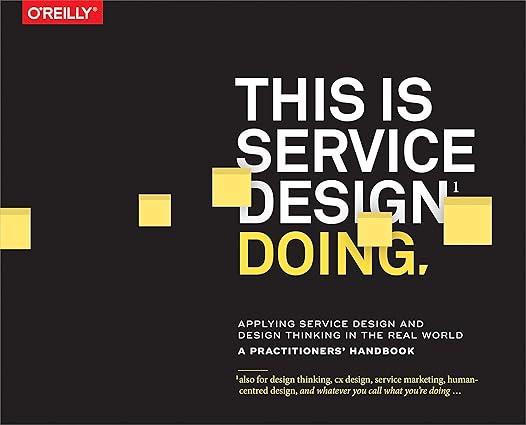White Paper: This Is Service Design Doing: Applying Service Design Thinking in the Real World
Introduction
Service design, a human-centered approach to designing services, has gained significant prominence in recent years. It focuses on creating meaningful and valuable experiences for users by considering their needs, desires, and behaviors throughout the entire service journey. This white paper explores the concept of service design and delves into the practical application of service design thinking as outlined in the book "This Is Service Design Doing."
The book, authored by Bill Moggridge and Michael Barry, provides a comprehensive guide to service design, offering insights into its principles, methodologies, and real-world applications. By examining the case studies and lessons presented in the book, this white paper aims to illuminate the power of service design in transforming businesses and improving customer experiences.
Body
Chapter 1: Understanding Service Design Thinking
Service design thinking is a human-centered approach to designing services that focuses on understanding user needs, defining the service experience, ideating innovative solutions, prototyping and testing, and implementing the final service. This iterative process involves a deep empathy for users, collaboration among stakeholders, and a focus on creating meaningful and impactful experiences.
- Core Concepts and Frameworks:
- User-centered design: Placing the user at the center of the design process to ensure that the service meets their needs and expectations.
- Human-centered innovation: Leveraging human insights and creativity to develop innovative and meaningful solutions.
- Journey mapping: Visualizing the user's experience from start to finish to identify pain points and opportunities for improvement.
- Service blueprints: Mapping the interactions between users, service providers, and back-end systems to understand the service ecosystem.
- The Six-Step Process of Service Design:
- Empathize: Gain a deep understanding of users' needs, motivations, and behaviors through research and observation.
- Define: Clearly define the problem or opportunity to be addressed and identify the key user needs and goals.
- Ideate: Generate a wide range of creative ideas and solutions to address the identified problem or opportunity.
- Prototype: Create tangible representations of the proposed service to test and refine the design.
- Test: Evaluate the prototypes with users to gather feedback and identify areas for improvement.
- Implement: Launch the final service and monitor its performance to ensure it meets user needs and business objectives.
Chapter 2: Applying Service Design in Practice
The book "This Is Service Design Doing" presents numerous case studies that demonstrate the application of service design thinking in various industries. By analyzing these examples, we can gain valuable insights into the practical challenges and opportunities associated with implementing service design projects.
- Case Studies:
- Healthcare: Improving patient experiences and outcomes through service design interventions.
- Education: Enhancing student engagement and learning experiences through innovative service design approaches.
- Technology: Designing intuitive and user-friendly interfaces for complex products and services.
- Retail: Creating memorable and personalized shopping experiences for customers.
- Challenges and Opportunities:
- Organizational culture: Overcoming resistance to change and fostering a culture of innovation and experimentation.
- Collaboration: Building effective cross-functional teams to ensure successful service design projects.
- Measurement: Developing metrics to track the impact of service design initiatives and demonstrate their value.
Chapter 3: The Impact of Service Design
Service design has the potential to create significant value for businesses and customers alike. By focusing on user experiences and delivering exceptional service, organizations can build strong customer relationships, increase customer satisfaction, and drive business growth.
- Benefits and Outcomes:
- Increased customer satisfaction: Delivering services that meet or exceed user expectations.
- Improved operational efficiency: Streamlining processes and reducing costs through service design interventions.
- Enhanced brand reputation: Creating a positive and memorable brand experience for customers.
- Innovation and differentiation: Developing unique and innovative service offerings.
- Ethical Considerations and Social Implications:
- Privacy and data security: Ensuring responsible use of user data and protecting privacy.
- Accessibility: Designing services that are inclusive and accessible to all users.
- Sustainability: Considering the environmental and social impact of service design decisions.
Chapter 4: Future Trends and Opportunities
The field of service design is constantly evolving, with new technologies and trends emerging that will shape its future. By staying informed about these developments, service designers can anticipate future challenges and opportunities.
- Emerging Trends:
- Digital transformation: Leveraging digital technologies to create innovative and personalized service experiences.
- Artificial intelligence and machine learning: Using AI and ML to automate tasks, personalize services, and improve decision-making.
- Internet of Things (IoT): Integrating IoT devices into service design to create connected and immersive experiences.
- Circular economy: Designing services that promote sustainability and reduce waste.
- Challenges and Opportunities:
- Ethical considerations: Addressing the ethical implications of emerging technologies in service design.
- Skills gap: Developing the necessary skills and expertise to navigate the changing landscape of service design.
- Collaboration: Fostering collaboration between service designers, technologists, and business leaders.
Conclusion
Service design is a powerful tool for creating meaningful and valuable experiences for users. By applying the principles and methodologies outlined in the book "This Is Service Design Doing," organizations can transform their businesses and build lasting relationships with their customers.
As the field of service design continues to evolve, it is essential for practitioners to stay informed about emerging trends and technologies. By embracing innovation and adapting to changing needs, service designers can play a vital role in shaping the future of business and society. Contact ias-research.com for details.
Reference List
- Moggridge, B., & Barry, M. (2016). This Is Service Design Doing: Applying Service Design Thinking in the Real World. Thames & Hudson.
- Norman, D. (2004). Emotional Design: Why We Love (or Hate) Everyday Things. Basic Books.
- Verhoef, P. C., & Lemon, K. (2002). The Value of Customer Relationships. Harvard Business Review, 80(4), 120-127.
- Kotler, P., & Armstrong, G. (2018). Principles of Marketing. Pearson.
- O'Brien, J. (2019). Service Design: A Beginner's Guide. Rosenfeld Media.



